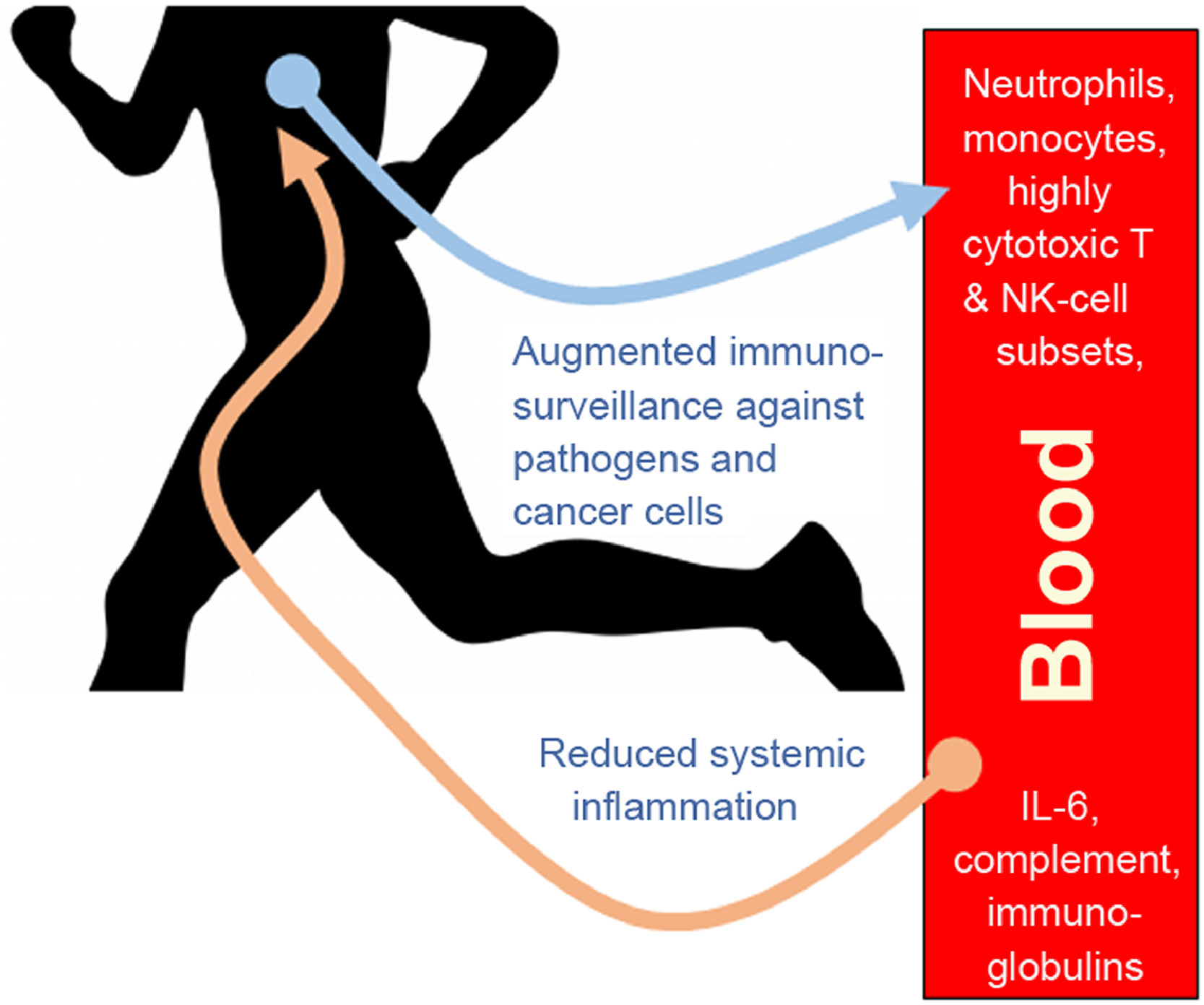(Bilingual Post) 答案是:可以,但是最大運動量需降低否則反而會降低免疫力,協助病毒擴散,害己害人(尤其針對平日運動量大的族群而言,例如鐵人三項和馬拉松運動員)
The answer is “YES, only if you lower the volume; otherwise, it does the opposite.” Below are highlights from an article in Journal of Sport and Health Science published in May, 2019. Title of the article is “The compelling link between physical activity and the body’s defense system”. It’s a meta review covering 179 research reports on this topic in the past 100 years.
本文摘譯自 “運動與健康科學期刊“ (Journal of Sport and Health Science) 一篇2019年5月發表的文章。文章的標題是 “The compelling link between physical activity and the body’s defense system”. 這是一篇整理性質的科學報告 (a review of scientific discoveries),涵蓋過去一百年來在這個議題上超過百篇以上的研究報告。這篇原文報告非常長,所有參考文獻(共179篇)皆有連結,有興趣的朋友可以點進去慢慢讀。小編這裡的重點摘譯,佔原文篇幅不到5%,只想點出主要訊息如下:
- 經常且適度的運動可以增強免疫力。
- 大量的運動,反而會降低免疫力。中鏢的風險會增加 200~600% !
Key takeaways from the report are:
- Adequate exercise on a regular basis can enhance immunity.
- High volume exercise (how much is high volume depends on individuality) causes immunity to drop. The chance of getting sick can increase as much as 200 – 600%.
關於第2點,有兩個很重要的觀念:一旦病毒進入你身體,你的免疫系統需要消耗很大額外的能量來對抗病毒,但在感染後4-14天的潛伏期裡你身體還沒有症狀出現,如果繼續大量運動,你的免疫系統就無法充分發揮功能,你就比較容易被感染 (此時你可能還沒有任何症狀), 進而大量增加你 身上病毒的數量 ,延長 攜帶病毒繼續傳染的天數。這就是防疫期間持續大量操練的風險!所以,在防疫期間,即使你沒有任何症狀,也要降低運動量,多保留能量給身體的免疫系統用;這樣不但能保護自己,更重要的是,更能 保護別人,真正成為整個社會防疫尖兵的一員。這樣的觀念和策略,跟外出接近人群時一定要戴口罩一樣,不能等到自己有症狀了才開始戴口罩。
量的拿捏比強度更重要。量要減少到60%以下,但強度可以不必降低那麼多。例如,強度很高但量很少的所謂 高強度間歇訓練 (例如,休息間隔不到兩分鐘的100~200公尺短跑衝刺跑個五、六次就收操) 不但不會降低免疫力,還可以提升免疫力,效果很明顯。
在COVID-19防疫期間,針對提高身體免疫力的目標,怎樣才不算是”過量的運動”呢?其實這篇期刊的文章沒有提供很明確的數字,只建議說每週五天,每天不要超過60分鐘。但根據我最近一個月從國外很多專家那邊學到的 (這些專家包括功能醫學大師、粉絲多達幾十萬的生理駭客((biohackers))、和鐵人三項精英選手),加上自己三鐵10年的經驗,想建議的是:
A.) 時間長度和頻率:每週三到五次,每次不超過60分鐘,以有氧運動為主。
B.) 訓練量(距離):不要超過疫情前自己平日最大訓練量的60%。游泳以賽前訓練高峰期每次最長泳距的60%為上限,騎車不超過個人賽前訓練高峰期每週里程數的60%,跑步控制在賽前訓練高峰期每週里程數的60%之內。
補充說明1:如果你已經有輕微的流感初期症狀,強烈建議停止所有運動,好好休息,每天到戶外空曠通風的地方散步20分鐘(如果有太陽更好)就夠了(當然要戴口罩)
補充說明2:如果你是一位運動菁英選手(an elite athlete),也許可以把上面的60%關卡推高到80%。這篇原文的研究報告裡有提到,他們觀察到的結論和提出的建議,不適用在某些奧運菁英選手身上,因為這些菁英選手可能因為體質優異,或是有受到特殊的照顧,可以忍受極限訓練,也不會影響到免疫系統。但這些是“奧運”級的選手。
以下是針對這篇研究報告的重點摘譯分享,我就繞著這兩張照片裡的圖表來說明。(有關兩張照片智慧財產權的特別說明:這兩張圖表是從這篇 公開免費 的研究報告裡下載另存後貼上去的,之所以不以原文網址直接帶出照片,是因為那樣只能顯示一張照片)

圖片一:運動如何提高身體免疫力 How exercise enhance immunity
強度夠且時間短的運動 會刺激 先天免疫系統細胞和成分 在淋巴組織和血液腔室之間的交流互換。 儘管是短暫的,但長期下來會產生累積效果,從而提高了對病原體和癌細胞的免疫監視能力,並降低系統性的體內發炎。
Acute exercise stimulates the interchange of innate immune system cells and components between lymphoid tissues and the blood compartment. Although transient, a summation effect occurs over time, with improved immunosurveillance against pathogens and cancer cells and decreased systemic inflammation.
在不超過60分鐘的中強度和高強度運動時,組織中 巨噬細胞抗病原體活性 的提高 與 免疫球蛋白、抗炎細胞因子、中性粒細胞、自然殺手細胞、細胞毒性T細胞 及 未成熟B細胞 (這些細胞均在免疫防禦和新陳代謝健康中發揮關鍵作用) 的再循環會同時發生。
這種不超過60分鐘的運動會優先調動具備高毒性和可能造成細胞組織轉移的 自然殺手細胞 和 毒性T淋巴細胞 ;因此,那些會降低免疫系統功能的 壓力荷爾蒙 以及會造成體內發炎的 細胞因子 在強度適中、不超過60分鐘的運動裡就不至於飆高。
長期累積下來,這樣的運動帶來的選擇性淋巴細胞亞群的增加可以增強免疫監測並降低體內發炎,對於肥胖和其他慢性病患者可能具有特殊的臨床價值。
During moderate- and vigorous-intensity aerobic exercise bouts of less than 60 min duration, the antipathogen activity of tissue macrophages occurs in parallel with an enhanced recirculation of immunoglobulins, anti-inflammatory cytokines, neutrophils, NK cells, cytotoxic T cells, and immature B cells, all of which play critical roles in immune defense activity and metabolic health.
Acute exercise bouts preferentially mobilize NK cells and CD8+ T lymphocytes that exhibit high cytotoxicity and tissue migrating potential. Stress hormones, which can suppress immune cell function, and proinflammatory cytokines, indicative of intense metabolic activity, do not reach high levels during short duration, moderate exercise bouts.
Over time, these transient, exercise-induced increases in selective lymphocyte subsets enhance immunosurveillance and lower inflammation, and may be of particular clinical value for obese and diseased individuals

圖片二:運動量和上呼吸道感染風險的J型曲線關係圖 Correlation curve between exercise volume and risk of upper respiratory tract infection
針對運動員在長時間大量運動後的免疫反應的測量一直受到學術界的高度重視。最好的證據顯示高運動量的訓練和密集的比賽項目和運動員的生理、代謝和心理負荷與免疫功能失調、體內發炎、氧化壓力和肌肉損傷有相關性。 自然殺手細胞和嗜中性粒細胞功能、各種T細胞和B細胞功能、唾液免疫球蛋白A的排放、皮膚延遲性過敏反應、巨噬細胞中主要組織相容性複合體的表達、以及其他 免疫功能的生理指標 在長時間大量的耐力運動後恢復過程的數小時至數天內都會有很大的改變(小編註:變差)。
The measurement of immune responses to prolonged and intensive exercise by athletes continues to receive high attention. Taken together, the best evidence supports that high exercise training workloads, competition events, and the associated physiological, metabolic, and psychological stress are linked to immune dysfunction, inflammation, oxidative stress, and muscle damage. NK cell and neutrophil function, various measures of T- and B-cell function, salivary IgA output, skin delayed-type hypersensitivity response, major histocompatibility complex II expression in macrophages, and other biomarkers of immune function are altered for several hours to days during recovery from prolonged and intensive endurance exercise
多項為期八週至1年的隨機臨床試驗一致顯示接受中等長度和中等強度訓練計劃的研究參與者的 “上呼吸道感染” (URTI, upper respiratory tract infections) 發生率比較低,發病期也比較短。在這些隨機臨床試驗中,每天進行適度運動的參與者,上呼吸道感染症狀日減少的幅度(通常減少40%–50%)超過了大多數藥物和營養補劑品的功效,…。 強度和長度適中的運動對疾病發病率的保護作用 與 長期密集運動訓練者的疾病風險的增加 有強烈的對比,如J曲線模型所顯示。
The randomized clinical trials (8 weeks to 1 year in length) are consistent in demonstrating that study participants assigned to moderate exercise programs experience reduced URTI incidence and duration. The magnitude of reduction in URTI symptom days with near-daily moderate exercise in these randomized clinical trials (typically 40%–50%) exceeds levels reported for most medications and supplements, .… The protective effect of moderate activity on illness incidence contrasts with the increased illness risk linked with prolonged and intensive exercise, as summarized in the J-curve model.

